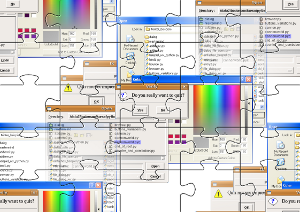Python Tkinter
Introduction
 We have often been asked: "Is there no Tk for Python?" or "Is Tkinter the same as Tk?"
Of course, there is Tk for Python. Without Tk Python would be less attractive to many users.
Tk is called Tkinter in Python, or to be precise, Tkinter is the Python interface for Tk.
Tkinter is an acronym for "Tk interface".
We have often been asked: "Is there no Tk for Python?" or "Is Tkinter the same as Tk?"
Of course, there is Tk for Python. Without Tk Python would be less attractive to many users.
Tk is called Tkinter in Python, or to be precise, Tkinter is the Python interface for Tk.
Tkinter is an acronym for "Tk interface".
Tk was developed as a GUI extension for the Tcl scripting language by John Ousterhout.
The first release was in 1991. Tk proved as extremely successful in the 1990's, because it is easier
to learn and to use than other toolkits. So it is no wonder that many programmers wanted to use Tk
independently of Tcl. That's why bindings for lots of other programming languages have been developed,
including Perl, Ada (called TASH), Python (called Tkinter), Ruby, and Common Lisp.
Tk provides the following widgets:
- button
- canvas
- checkbutton
- combobox
- entry
- frame
- label
- labelframe
- listbox
- menu
- menubutton
- message
- notebook
- tk_optionMenu
- panedwindow
- progressbar
- radiobutton
- scale
- scrollbar
- separator
- sizegrip
- spinbox
- text
- treeview
- tk_chooseColor - pops up a dialog box for the user to select a color.
- tk_chooseDirectory - pops up a dialog box for the user to select a directory.
- tk_dialog - creates a modal dialog and waits for a response.
- tk_getOpenFile - pops up a dialog box for the user to select a file to open.
- tk_getSaveFile - pops up a dialog box for the user to select a file to save.
- tk_messageBox - pops up a message window and waits for a user response.
- tk_popup - posts a popup menu.
- toplevel - creates and manipulates toplevel widgets.
- place - which positions widgets at absolute locations
- grid - which arranges widgets in a grid
- pack - which packs widgets into a cavity



